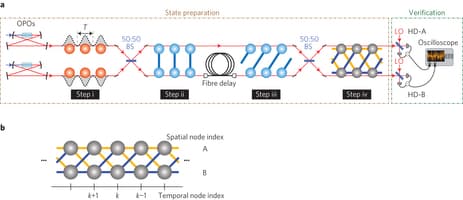World's Largest Quantum Circuit Board Created By Tokyo & Australian University Researchers
In what set a wave of quantum computing news all over the tech town, researchers from University of Tokyo and Australian National university have accomplished a never seen before feat. They have taken a huge step towards building the first quantum computer by developing the world's largest quantum circuit board. Quantum computers which promise ultrafast performance for certain tasks, require large cluster states for long computations. A circuit board is an essential component for a quantum computer made of laser light. The research conducted by these two international universities have helped see the largest number of quantum systems brought together in a single component jump from 14 to 10,000.
The design proposed by Dr. Nicolas Menicucci, from the University of Sydney’s School of Physics has allowed Furusawa’s research team to construct a ‘circuit board’ of more than 10,000 quantum systems – an increase of three orders of magnitude over the nearest competing design. This means they have achieved a world record for the largest quantum resource ever produced in which every part can be accessed directly and individually, which is essential if it is to be useful for quantum computing.

Schematic of the experimental set-up and ultra-large-scale XEPR state.
“The transistor, invented in the mid-1940s, replaced vacuum tubes in ordinary computers with components that can be mass produced,†said Dr Nicolas Menicucci, from the University of Sydney’s School of Physics. “The scalability afforded by transistors enabled the explosion in computing technology we’ve seen in the last 65 years. Similarly, this breakthrough promises scalable design of laser-light quantum computing hardware,†Menicucci said.
Eesearchers at the University of Tokyo, led by Professor Akira Furusawa worked hard to achieve this goal. A working quantum computer would exploit the mysterious properties of quantum physics, allowing the most difficult computational problems – impractical for even the fastest supercomputers – to become feasible to solve. “The two main obstacles to creating quantum computers are the precise control of tiny quantum systems and the issue of scalability, which is the ability to make bigger and bigger quantum computers out of small parts,†said Menicucci.
The study is published in journal #-Link-Snipped-#.
The design proposed by Dr. Nicolas Menicucci, from the University of Sydney’s School of Physics has allowed Furusawa’s research team to construct a ‘circuit board’ of more than 10,000 quantum systems – an increase of three orders of magnitude over the nearest competing design. This means they have achieved a world record for the largest quantum resource ever produced in which every part can be accessed directly and individually, which is essential if it is to be useful for quantum computing.

Schematic of the experimental set-up and ultra-large-scale XEPR state.
“The transistor, invented in the mid-1940s, replaced vacuum tubes in ordinary computers with components that can be mass produced,†said Dr Nicolas Menicucci, from the University of Sydney’s School of Physics. “The scalability afforded by transistors enabled the explosion in computing technology we’ve seen in the last 65 years. Similarly, this breakthrough promises scalable design of laser-light quantum computing hardware,†Menicucci said.
Eesearchers at the University of Tokyo, led by Professor Akira Furusawa worked hard to achieve this goal. A working quantum computer would exploit the mysterious properties of quantum physics, allowing the most difficult computational problems – impractical for even the fastest supercomputers – to become feasible to solve. “The two main obstacles to creating quantum computers are the precise control of tiny quantum systems and the issue of scalability, which is the ability to make bigger and bigger quantum computers out of small parts,†said Menicucci.
The study is published in journal #-Link-Snipped-#.
0
